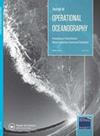On extracting high-frequency tidal variability from HF radar data in the northwestern Bay of Bengal
IF 2.4
3区 地球科学
Q4 METEOROLOGY & ATMOSPHERIC SCIENCES
引用次数: 19
Abstract
ABSTRACT First results from a systematic harmonic analysis of HF radar (HFR) derived ocean surface current observations in the northwestern Bay of Bengal (BoB) during 2010 is presented. The daily-averaged HFR currents compared reasonably well to composite daily surface currents from multiple satellites with correlation coefficient of 0.90 (0.69) for zonal (meridional) component. A set of sequential daily currents demonstrated sustained northward (southward) alongshore flow during February–April (October–December) with peak magnitude of about 1.8 (1.2) m/s. On tidal scales, harmonic analyses of zonal and meridional components at nearshore and offshore locations indicated that among semi-diurnal tidal components, M2 dominates over S2 and N2; time-scales of which were verified from available coastal tide gauges nearby. Amplitudes of semi-major axis for M2 and K1 tidal ellipses are 7.16 (6.13) and 4.02 (3.30) cm/s in nearshore (offshore) location indicating relatively stronger tidal currents in nearshore location. Finally, significant shallow water constituents S4, MS4 and M3 (M4, 2SM6 and M6) at nearshore (offshore) location are identified, which are due to non-linear interaction of tidal currents with bathymetry. Both semi-diurnal and shallow water tidal currents show dominance along isobaths in offshore region, which turn progressively across-isobath as they move nearshore.利用孟加拉湾西北部高频雷达资料提取高频潮汐变率的研究
本文首次对2010年孟加拉湾西北部短波雷达(HFR)海面流观测数据进行了系统谐波分析。日平均HFR流与多颗卫星的复合日地面流比较良好,纬向(经向)分量的相关系数为0.90(0.69)。一组连续的日流在2 - 4月(10 - 12月)期间显示持续的北(南)岸流,峰值幅度约为1.8(1.2)米/秒。在潮汐尺度上,近岸和近海纬向和经向分量的调和分析表明,在半日潮分量中,M2大于S2和N2;时间尺度是由附近可用的海岸潮汐计核实的。近岸(近海)位置M2和K1潮汐椭圆半长轴振幅分别为7.16(6.13)和4.02 (3.30)cm/s,表明近岸位置潮流相对较强。结果表明,近岸(近海)浅水组分S4、MS4和M3 (M4、2SM6和M6)具有重要意义,是潮流与水深测量非线性相互作用的结果。近岸地区半日流和浅水潮流在等深线上均占主导地位,并在近岸地区逐渐转向横越等深线。
本文章由计算机程序翻译,如有差异,请以英文原文为准。
求助全文
约1分钟内获得全文
求助全文
来源期刊
CiteScore
7.50
自引率
9.70%
发文量
8
审稿时长
>12 weeks
期刊介绍:
The Journal of Operational Oceanography will publish papers which examine the role of oceanography in contributing to the fields of: Numerical Weather Prediction; Development of Climatologies; Implications of Ocean Change; Ocean and Climate Forecasting; Ocean Observing Technologies; Eutrophication; Climate Assessment; Shoreline Change; Marine and Sea State Prediction; Model Development and Validation; Coastal Flooding; Reducing Public Health Risks; Short-Range Ocean Forecasting; Forces on Structures; Ocean Policy; Protecting and Restoring Ecosystem health; Controlling and Mitigating Natural Hazards; Safe and Efficient Marine Operations

 求助内容:
求助内容: 应助结果提醒方式:
应助结果提醒方式:


